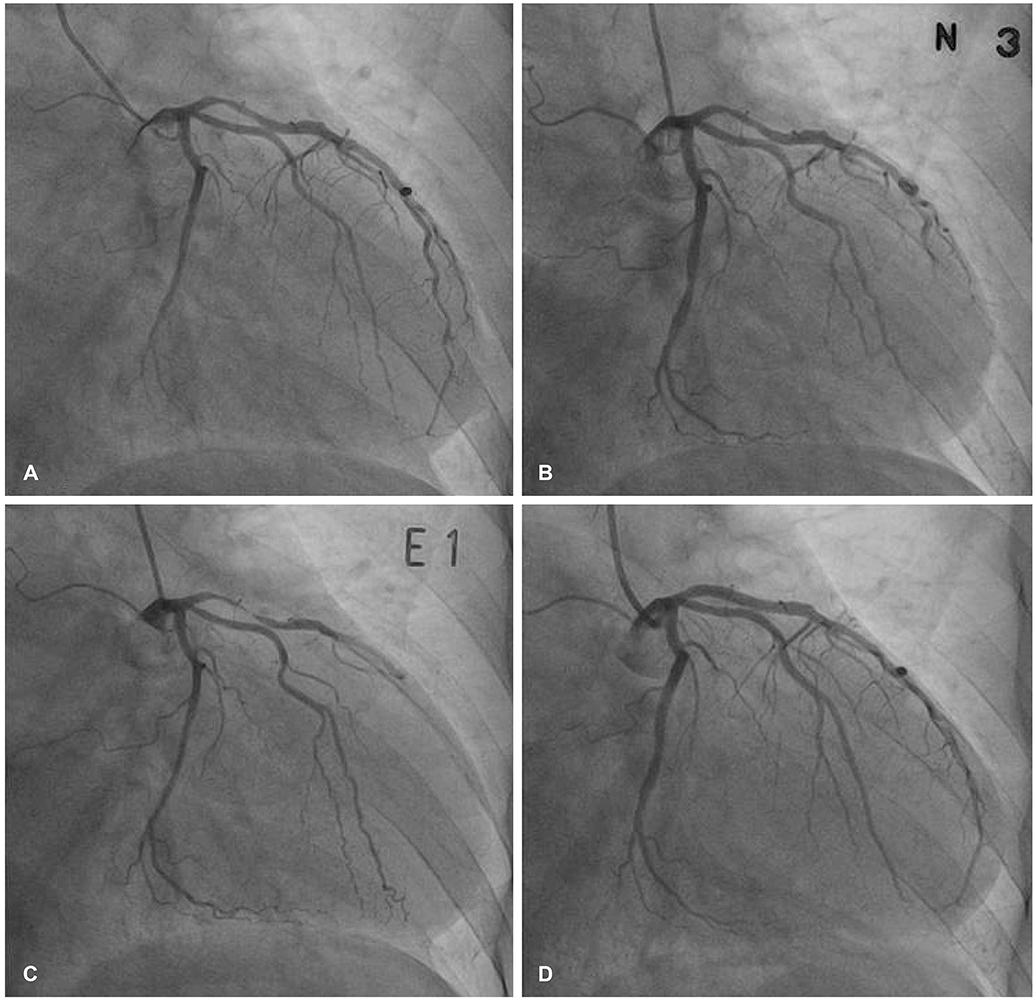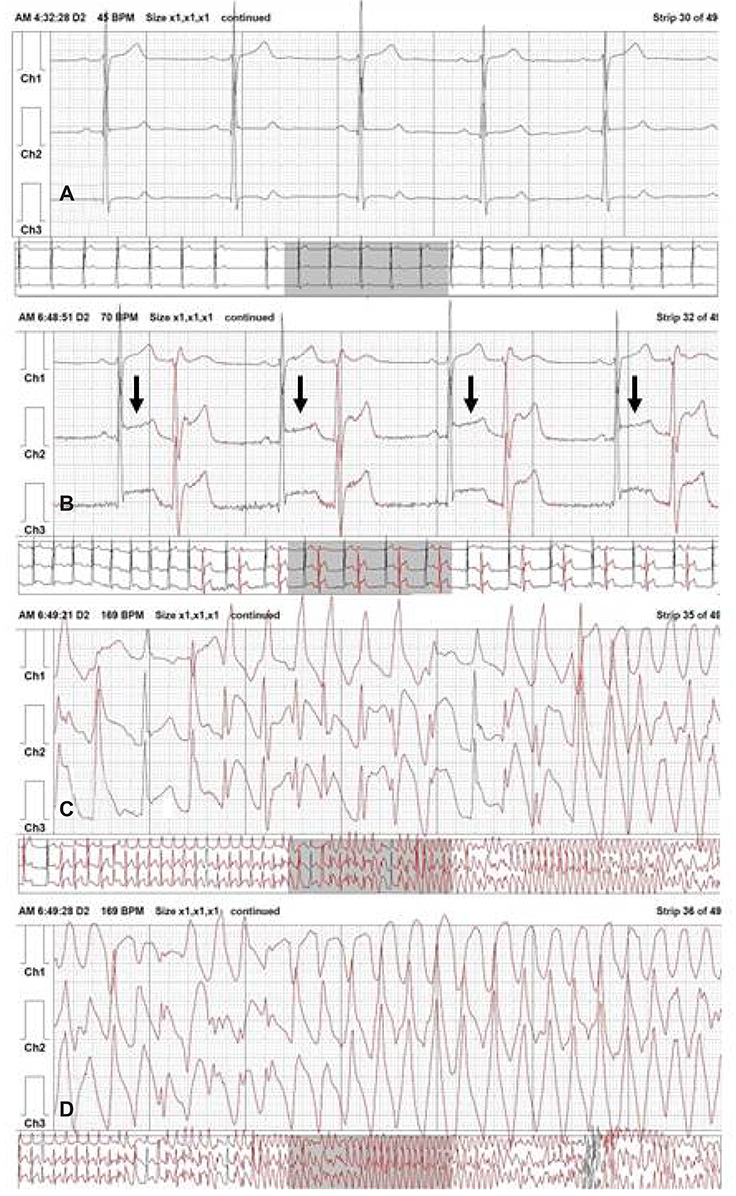Korean Circ J.
2016 Jan;46(1):102-106. 10.4070/kcj.2016.46.1.102.
Ventricular Tachycardia Associated Syncope in a Patient of Variant Angina without Chest Pain
- Affiliations
-
- 1Department of Cardiology, Dong-A University Medical Center, Busan, Korea. thpark65@dau.ac.kr
- KMID: 2223776
- DOI: http://doi.org/10.4070/kcj.2016.46.1.102
Abstract
- A 68-year-old man was admitted for a syncope workup. After routine evaluation, he was diagnosed with syncope of an unknown cause and was discharged from the hospital. He was readmitted due to dizziness. On repeated Holter monitoring, polymorphic ventricular tachycardia was detected during syncope. We performed intracoronary ergonovine provocation test; severe coronary spasm was induced at 70% stenosis of the proximal left anterior descending artery. The patient was treated with percutaneous coronary intervention. We present a rare case of syncope induced by ventricular arrhythmia in a patient with variant angina without chest pain.
MeSH Terms
Figure
Reference
-
1. Prinzmetal M, Kennamer R, Merliss R, Wada T, Bor N. Angina pectoris. I. A variant form of angina pectoris; preliminary report. Am J Med. 1959; 27:375–388.2. Kusama Y, Kodani E, Nakagomi A, et al. Variant angina and coronary artery spasm: the clinical spectrum, pathophysiology, and management. J Nippon Med Sch. 2011; 78:4–12.3. Kishida H, Tada Y, Fukuma N, Saitoh T, Kusama Y, Sano J. Significant characteristics of variant angina patients with associated syncope. Jpn Heart J. 1996; 37:317–326.4. Yasue H, Takizawa A, Nagao M, et al. Long-term prognosis for patients with variant angina and influential factors. Circulation. 1988; 78:1–9.5. Lanza GA, Sestito A, Sgueglia GA, et al. Current clinical features, diagnostic assessment and prognostic determinants of patients with variant angina. Int J Cardiol. 2007; 118:41–47.6. European Heart Rhythm Association. Heart Rhythm Society. Zipes DP, et al. ACC/AHA/ESC 2006 guidelines for management of patients with ventricular arrhythmias and the prevention of sudden cardiac death: a report of the American College of Cardiology/American Heart Association Task Force and the European Society of Cardiology Committee for Practice Guidelines (Writing Committee to Develop guidelines for management of patients with ventricular arrhythmias and the prevention of sudden cardiac death). J Am Coll Cardiol. 2006; 48:e247–e346.7. Myerburg RJ, Kessler KM, Mallon SM, et al. Life-threatening ventricular arrhythmias in patients with silent myocardial ischemia due to coronary-artery spasm. N Engl J med. 1992; 326:1451–1455.8. Postorino C, Gallagher MM, Santini L, et al. Coronary spasm: a case of transient ST elevation and syncopal ventricular tachycardia without angina. Europace. 2007; 9:568–570.9. Yoo SY, Shin DH, Jeong JI, et al. Long-term prognosis and clinical characteristics of patients with variant angina. Korean Circ J. 2008; 38:651–658.10. Chin A, Casey M. Variant angina complicated by polymorphic ventricular tachycardia. Int J Cardiol. 2010; 145:e47–e49.11. Tanabe Y, Itoh E, Suzuki K, et al. Limited role of coronary angioplasty and stenting in coronary spastic angina with organic stenosis. J Am Coll Cardiol. 2002; 39:1120–1126.12. Gaspardone A, Tomai F, Versaci F, et al. Coronary artery stent placement in patients with variant angina refractory to medical treatment. Am J Cardiol. 1999; 84:96–98. A813. Berntsen RF, Gunnes P, Lie M, Rasmussen K. Surgical revascularization in the treatment of ventricular tachycardia and fibrillation exposed by exercise-induced ischaemia. Eur Heart J. 1993; 14:1297–1303.14. Matsue Y, Suzuki M, Nishizaki M, Hojo R, Hashimoto Y, Sakurada H. Clinical implications of an implantable cardioverter-defibrillator in patients with vasospastic angina and lethal ventricular arrhythmia. J Am Coll Cardiol. 2012; 60:908–913.
- Full Text Links
- Actions
-
Cited
- CITED
-
- Close
- Share
- Similar articles
-
- A case of complete atrioventricular block persisting for 5 days in a patient with variant angina
- Repeated Ventricular Fibrillation during Emergence of General Anesthesia Caused by Variant Angina: A case report
- Ventricular Tachycardia due to Submucosal Epinephrine Injection during Septoplasty
- Reversed Circadian Variation in Variant Angina
- Variant Aangina Diagnosed by Beta-Blocker Provocation Test and a Case of Subendocardial inFarction Induced by This Test



